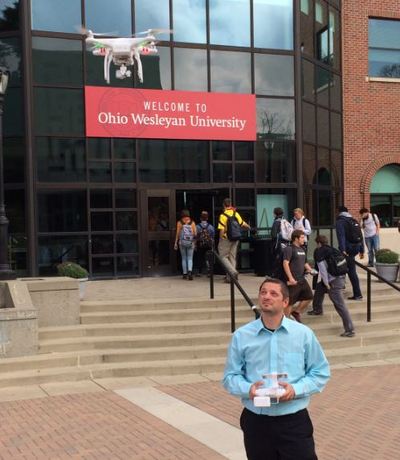The commercial and private use of drones is soaring. The devices are capturing news video, assisting farmers, filming movies, delivering packages, surveying real estate, recording vacation travel logs, and providing disaster relief. Lux Research projects the market for commercial drones will reach $1.7B by 2025. Each year, $6.4 billion is being spent developing drone technology. As the Internet of Things continues to expand, drones of all sizes are taking their place among IoT devices feeding back torrents of data for analysis.
Along with the drones come new jobs. In the US alone, 70,000 new drone-related jobs are projected within the next three years; 100,000 new jobs are expected by 2025. In order to provide a trained workforce capable of meeting this demand, schools are already jumping in and offering drone programs and degrees.
Brian A. Rellinger, CIO Ohio Wesleyan University has been experimenting with drones on campus to see firsthand how they can used to enhance teaching, learning, research, and service to society. Some OWU students are already bringing drones on campus, further extending the bring your own device concept. I spoke with Brian about all the ways drones can be used for educational purposes. We compiled the list of Ten Uses of Drones in Higher Education below, which is presented in the accompanying slideshare.
Brian Rellinger (Twitter: @rellinb) learning to fly a drone on the campus of Ohio Wesleyan University
- Enable student projects exploring the intersection between art and technology and research, such as gathering data from sacred forests in Ethiopia, mapping lava flows in Ecuador, and surveying the forest canopy in Costa Rica.
- Loan drones to students for checkout and experimentation.
- Drones are used to capture unique footage of sporting events.
- Create promotional flybys of key campus buildings and features and virtual holiday greeting videos.
- Record footage of unique campus events, such as picnics or move-in weekend.
- Take unique photographs from hard to reach places.
- Facilitate inspections of buildings and monitor construction projects.
- Enhance field projects, such as studying wildlife from a distance, and detailed 3D archaeological mapping
- Monitor agricultural and environmental conditions
- Teach a course on designing and building drones
Drones are also finding their way into K-12 education. The Drones for Schools program is one such K-12 activity. The Greenon High School in Springfield, Ohio, has another program in which students use drone software and perform tasks like mapping out data from a natural disaster and creating a safe evacuation plan.
The cost of drones for educational use ranges from $500 to $3,000 depending on the features, battery life, camera quality, and accessories. They are small and easily transportable, and can fit in a ruggedized hard case for travel. It is possible to utilize open source software for real-time telemetry and to create 3D flight path files viewable with Google Earth, expanding the possible research uses.
Like many new, leading edge technologies, drones come with some concerns. It is important to plan appropriately to achieve a positive outcome. Privacy, policy and the negative connotation of the word drone, are all issues to be considered. Many users of the devices for commercial purposes prefer to call them by other names, including flybot, copter, UAV (unmanned aerial vehicle), RPA (remotely piloted aircraft), UAS (unmanned aircraft system), unmanned aircraft, or just robot. Understanding the concerns and setting clear objectives are key to successfully using drones on your campus.
On the policy front, the Academy of Model Aeronautics (AMA), a leading community-based organization, has provided guidelines. The AMA, established in 1936, 22 years prior to the founding of the FAA, is petitioning the FAA for a reasonable approach to addressing drone usage. In the meantime, the FAA has issued an interpretation of the Special Rule for Model Aircraft which may seriously impact the use of small drones by institutions and the general public.
Dr. Coye Cheshire, associate dean and associate professor at University of California Berkeley, who led a drone lab experiment in 2013 found that, "Our students emphasized the fun, creative, social and playful side of autonomous flying devices. They developed ways to navigate the devices by voice commands, to 'air dance' to music, and other creative applications that become possible when you put a bunch of sensors on a quad-copter and tinker with it."
Ohio Wesleyan University senior Andrew Wallace, who purchased his own drone, states, "I think the possibilities are endless. From a marketing standpoint, drones offer a way to see the entire campus in a different way. You can capture almost any outdoor event in a less intrusive manner and in a way that people really get excited about."
In addition to co-author Brian Rellinger, the following people contributed to this post:
- David Smallen, VP for Libraries and Information Technology at Hamilton College
- Melissa Woo, Vice Provost for Information Services and Chief Information Officer at University of Oregon
- Kevin Lynch, Chief Information Officer at Colgate University
- Robert Nilsson, Director Vertical Solutions at Extreme Networks
The topic of drones in higher education is just beginning to emerge; we would love to hear more ideas on ways drones can be used in higher education. Tweet us at @rellinb, @hamcio, @mzyw, @raidercio, @RHnilsson, @ValaAfshar if you have additional ideas!

